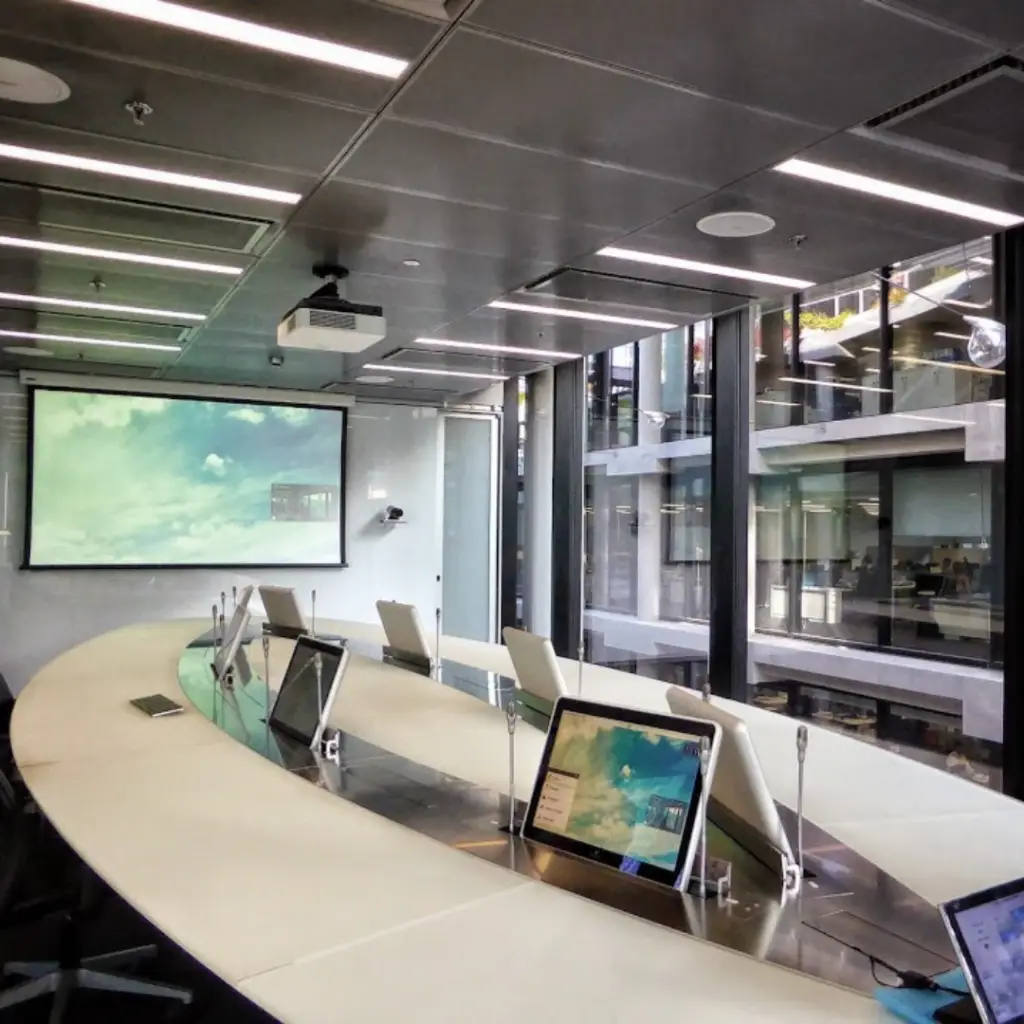Enhancing Small Meeting Rooms with Advanced AV Tech for a More Human Connection
In today’s hybrid work environment, connecting remote and office-based employees seamlessly has become a critical component for productivity and team cohesion. As businesses adapt to this new reality, advanced audiovisual (AV) technology is transforming small meeting rooms into dynamic spaces that facilitate more natural and engaging interactions. The aim is to move beyond traditional video conferencing platforms like Zoom and create a meeting experience that feels more human and connected.
Current AV Technology Enhancements
Several advanced AV technologies are currently being implemented to bridge the gap between remote and in-office participants, making meetings more immersive and collaborative.
High-Resolution Cameras and Microphones:
Modern meeting rooms are equipped with high-resolution cameras that provide clear, lifelike video. Cameras with auto-tracking capabilities can follow speakers as they move, ensuring remote participants have a consistent view of the speaker. Advanced microphones with noise-cancelling features capture clear audio, minimizing background noise and ensuring everyone can hear and be heard distinctly.
Smart Displays and Interactive Whiteboards:
Large, high-definition displays paired with interactive whiteboards allow in-room and remote participants to collaborate in real-time. These tools enable users to share, annotate, and manipulate documents and presentations seamlessly, creating an interactive experience that mimics in-person collaboration.
Room Acoustic Design:
Good acoustic design is crucial for effective communication. Acoustic panels, soundproofing materials, and strategically placed microphones enhance sound quality, making conversations clearer and more natural. This minimizes the echo and reverberation often experienced in poorly designed spaces.
AI and Machine Learning:
AI-driven technologies are being integrated into meeting rooms to provide features like real-time transcription, translation, and meeting analytics. AI can also enhance video quality by adjusting lighting and focus automatically, ensuring participants look their best on camera.
Virtual Reality (VR) and Augmented Reality (AR) in Meetings
Beyond traditional AV technologies, research into Virtual Reality (VR) and Augmented Reality (AR) is showing promise in making remote meetings feel even more connected and immersive.
VR Meeting Spaces:
VR platforms create virtual meeting spaces where participants can interact as avatars in a shared environment. This technology can simulate the experience of being in the same room, providing spatial audio and 3D visuals that make interactions more engaging. Companies like Spatial and Facebook’s Horizon Workrooms are at the forefront of developing VR meeting solutions.
AR Enhancements:
AR can overlay digital information onto the physical world, enhancing the meeting experience for in-room participants. For example, AR glasses can display real-time data, participant information, or shared documents, providing a rich layer of contextual information without disrupting the flow of conversation.
Mixed Reality (MR) Solutions:
Mixed Reality combines elements of both VR and AR to create hybrid meeting environments. MR can be particularly useful for collaborative tasks that require a combination of digital and physical tools, such as design and engineering projects. This technology allows participants to interact with 3D models and prototypes as if they were tangible objects.
Research and Future Directions
Emerging research indicates that VR and AR technologies can significantly enhance the sense of presence and engagement in remote meetings. Studies have shown that VR meetings can reduce fatigue compared to traditional video calls, as the immersive environment helps participants focus and feel more connected.
Researchers are also exploring the psychological impacts of avatar-based interactions. Early findings suggest that avatars can reduce social anxiety and make participants more comfortable sharing ideas, potentially leading to more productive meetings.
Conclusion
The evolution of AV technology is revolutionizing how small meeting rooms are used, making it possible to connect remote and office-based employees in a way that feels more natural and human. High-resolution cameras, smart displays, and AI-driven enhancements are improving the quality of virtual interactions, while VR and AR technologies promise to take these improvements even further.
As these technologies continue to develop, the future of hybrid work looks increasingly promising. By creating more immersive and engaging meeting experiences, businesses can ensure that all employees, regardless of location, feel equally involved and connected, fostering a more cohesive and productive work environment.

Chris Kmiec
A self confessed AV nerd, Chris is a graduate of Surrey University and has over 15 years experience with commercial AV design for venues of all types in every corner of the world.

